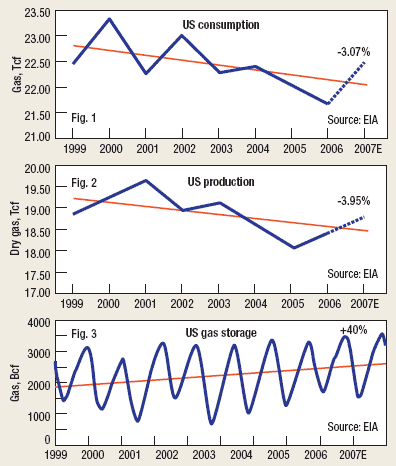US gas supply and demand. I’m tired of trying to make sense of oil data. After writing the OPEC report (page 101) as a result of a recent trip, where more oil data was presented and gathered for analysis by this Editor, I thought I’d try something easier and look at natural gas data. As goofy as gas data is, even with all the court cases and the charges of price manipulation going on, relative to oil, it makes perfectly good sense. T. Boone Pickens said recently that the historic 6-to-1 price ratio of oil to gas would have to be reestablished within the next year or so. This is based on the fact that, ordinarily, on an energy basis, it takes six times as much gas as it does oil to provide heat for an industrial process. Thus, the 4% or so of companies that are able to switch fuels will do so if there’s a sufficient economic advantage. Except for the period immediately after hurricanes Katrina and Rita, oil prices have been consistently more than six times, and lately more than 12 times, the price of gas (depending on which price and quality of oil you use). Gas is cheap relative to oil. By now, everyone who could switch to gas has done so. And yet, demand is slack. I looked back at a column I wrote in 1999 that cited a Gas Research Institute report that said the US would be using 30 Tcf of gas a year by 2015. Since that prediction, US consumption has been steadily going down, about 3% over the past nine years, as measured by a trend line, Fig. 1. Somehow, gas consumption has become decoupled not only from oil, but also from economic growth. Generally speaking, people and companies are just figuring out ways to use less of the stuff. Production has also been falling, only slightly more than consumption, at about 4% over the nine-year period, Fig. 2. Storage has been stubbornly high in recent years, and has been at about 9% (and higher) above the five-year average for much of the past two years. Which brings up a funny thing about five-year averages: even if they are completely out of whack, if they stay that way for several years, they become the five-year norms. On an absolute basis, which includes expansion in storage capacity, storage is up 40% over the nine-year period, Fig. 3. LNG imports have been up and down in recent years, and depend entirely on gas prices elsewhere, especially in Europe, where lately, they have increased substantially. LNG vessels simply take a left turn and go to whatever country is paying the highest price. With consumption and production down, and LNG imports up, imports from Canada have taken a hit, which has been reflected, in part, in the sharp decline in Canadian drilling activity the last two years. Oddly, it’s not so bad for two reasons: Tar sands projects can use that gas domestically; and the weak US dollar relative to the Canadian dollar, the loonie, means that in 2003, US$6 gas, which resulted in 9.5 loonies, now yields only 5.85 loonies-a 38% decrease in Canadian loonies. It’s not a good time to be exporting to the US, especially if you’re from Canada.
Domestic supply should see an upturn at the end of 2007 and into 2008, with two major pipelines completed in Colorado and the Midwest, plus Independence Hub in the Gulf, which is now producing 850 MMcfd out of its possible 1 Bcfd capacity. And yet, even with all that, production struggles. Government subsidies to the rescue. The Energy Bill that was just signed into law by President Bush includes massive federal subsidies for expanding biofuels production. It calls for 2.34 million barrels a day of renewable fuels production by 2022. That’s about 21% of US gasoline consumption even after adjusting for energy content-a huge amount by any measure. It will likely require most, if not all, of US corn production to achieve, certainly in the short term, depending on technological breakthroughs in other biofuels. I have no idea why this president and Congress (and the last Congress) are so enamored with biofuels...well, actually, I do-it’s vote buying, plain and simple, with Democrats and Republicans playing a game of one-upmanship to see who can spend the most taxpayer money in the cornbelt states. One good thing-it’s also a subsidy to the oil industry, not just as a fuel additive, but also as a support for exploration, production and drilling. The Congressional Research Service issued a report in December 2007, titled “Selected issues related to an expansion of the Renewable Fuel Standard (RFS).” Using that data, if only one-half of the RFS mandate was met by using ethanol-and it will almost certainly be more than that-gas consumption would increase 0.9 Tcf a year. This is the equivalent of 4.4% of 2006 US supply. I have no idea where we will get this gas. Expensive LNG imports, I suppose. Expect higher natural gas prices. And, of course, higher electricity and food costs for everyone.
|
||||||||
- Prices and governmental policies combine to stymie Canadian upstream growth (February 2024)
- U.S. producing gas wells increase despite low prices (February 2024)
- U.S. drilling: More of the same expected (February 2024)
- U.S. oil and natural gas production hits record highs (February 2024)
- U.S. upstream muddles along, with an eye toward 2024 (September 2023)
- Canada's upstream soldiers on despite governmental interference (September 2023)
- Applying ultra-deep LWD resistivity technology successfully in a SAGD operation (May 2019)
- Adoption of wireless intelligent completions advances (May 2019)
- Majors double down as takeaway crunch eases (April 2019)
- What’s new in well logging and formation evaluation (April 2019)
- Qualification of a 20,000-psi subsea BOP: A collaborative approach (February 2019)
- ConocoPhillips’ Greg Leveille sees rapid trajectory of technical advancement continuing (February 2019)





